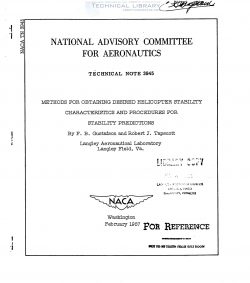naca-tn-3945
- Version
- 104 Downloads
- 1.08 MB File Size
- 1 File Count
- January 31, 2017 Create Date
- January 31, 2017 Last Updated
National Advisory Committee for Aeronautics, Technical Notes - Methods for Obtaining Desired Helicopter Stability Characteristics and Procedures for Stability Predictions

In the first part of this report a brief review is presented.of
methods available to the helicopter designer for obtaining desired sta-
bility characteristics by modifications to the airframe design. The dis-
cussion is based on modifications made during the establishment of flying—
qualities criteria and includes sample results of theoretical studies of"
additional methods.
The conclusion is reached that it is now feasible to utilize combi-
nations of methods whereby stability—parameter values are realized which
in turn provide the desired stability characteristics.
Part II reviews some of the methods of predicting rotor stability
derivatives. The procedures by which these rotor derivatives are
employed to estimate helicopter stability characteristics have been sum-
marized. Although these methods are not always adequate for predicting
absolute values of the stability of the helicopter, the effects on sta—
bility of changes in individual derivatives can generalLy'be estimated
satisfactorily.
The problems relating to stability of helicopters have been the sub—
Ject of numerous published works. Requirements established by the mili—
tary services for satisfactory helicopter stability are—specified‘In
reference 1. Some of the pertinent work on this subject by the National
Advisory Committee for Aeronautics is described in references 2 to 21.
The purpose of part I of this paper is to summarize some of the physical
methods available to the designer for obtaining desired stability values
by changing the airframe design. Although_the direct application con—
sidered is thatrof meeting flying-qualities criteria, it may be worth
pointing out that other reasons often arise for designing a configuration
so that specific amounts of stability are provided; for example, the most
efficient combination of autopilot—and airframe design may be desired.
In order to predict helicopter stability, as for example to estimate V _;;
theoretically whether a prOposed helicopter will meet the_flying- qualities
requirements, both the applicable equations of motion and the necessary.
stability derivatives must be determined.
| File | Action |
|---|---|
| naca-tn-3945 Methods for Obtaining Desired Helicopter Stability Characteristics and Procedures for Stability Predictions.pdf | Download |
Comment On This Post